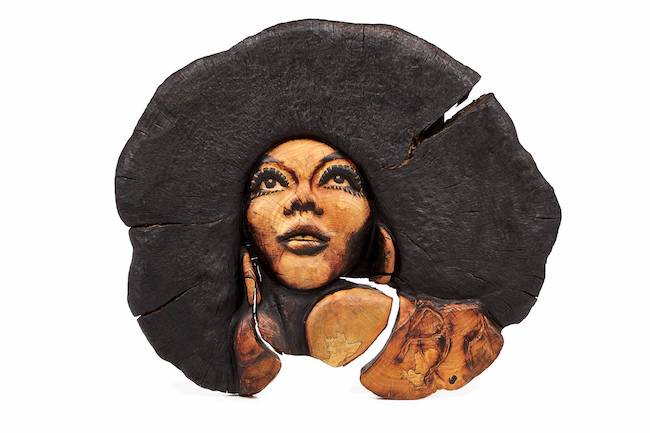Immaginare mondi diversi da quello appartenente alla realtà contingente, è una manifestazione artistica che ha avuto la capacità magnetica di attrarre l’osservatore proprio in virtù di quella bizzarria, di quell’essere simile a qualcosa di visto e al tempo stesso completamente differente; nella scultura infondere il senso di distacco dall’osservato, evocando un mondo possibile e slegato dalla contingenza, è stato più complesso, meno facilmente comprensibile rispetto alla pittura. L’artista di cui vi parlerò oggi riesce perfettamente a delineare una realtà parallela a quella oggettiva attraverso l’utilizzo del legno, materiale duttile e per questo in grado di divenire voce espressiva di grande intensità.
Con l’inizio del Novecento la ricerca artistica si spostò dalla forma estetica e dalla riproduzione della realtà osservata verso l’esplorazione del sentire interiore, quell’approccio inizialmente abbracciato dall’Espressionismo ma poi diffuso a molte altre correnti di quegli anni, benché con sfumature differenti. Quei primi passi mossi dagli espressionisti furono paralleli a una visione filosofica e culturale definita Esistenzialismo che cercava di indagare i disagi, le paure, il senso di perdita delle certezze e la solitudine interiore dell’uomo nel periodo a cavallo tra il Diciannovesimo e il Ventesimo secolo e che ispirò gli studi sulla psiche e i movimenti artistici dei successivi decenni. L’irrealtà e il mondo dei sogni, così come degli incubi, divennero le linee guida del Surrealismo che proprio sull’indagine della mente inconscia basò tutta la sua poetica, l’intento espressivo e il successo delle opere di artisti come Salvador Dalì, René Magritte, Max Ernst, Hans Arp, Yves Tanguy, in cui lo sguardo era catturato dagli elementi conosciuti che però assumevano un significato completamente differente da quello quotidiano, proprio perché decontestualizzati, modificati e plasmati dall’illogico onirico, o in altri casi assolutamente discostanti e appartenenti a un mondo parallelo mai riscontrabile nell’oggettività. A questa corrente affascinante, enigmatica e a volte inquietante, si avvicinò uno scultore decisamente fuori dagli schemi non tanto per la forma data alle sue opere quanto per il senso di disorientamento, di incredibile solitudine e di inconsistenza che il suo uomo esprimeva, esile e fragile davanti alle difficoltà del vivere dell’epoca; parlo ovviamente di Alberto Giacometti che costituì una voce fuori dal coro rispetto alle linee guida del Surrealismo, dando vita di fatto a un Esistenzialismo artistico e che aprì la strada a considerazioni e personalizzazioni riscontrabili nell’Espressionismo di Egon Schiele, nel Realismo nordico del danese Vilhelm Hammershøi e nel Realismo Americano di Edward Hopper, in cui viene evidenziato il senso di solitudine, il silenzio interiore dentro cui l’essere umano si rifugia o, al contrario, si trova suo malgrado a vivere. Laddove Giacometti predilige il bronzo per raccontare la vacuità dell’essere umano, lo scultore austriaco Andreas Mathes riprende il tema della solitudine dell’uomo contemporaneo scegliendo il legno per dare il suo punto di vista, meno angosciato, più coinvolto nella natura che viene considerata come elemento essenziale per una potenziale salvezza, per alleviare il senso di solitudine che avvolge un vivere attuale in cui l’individualismo sembra essere l’imperativo da seguire. Le opere di grandi dimensioni di Mathes sono spesso collocate in contesti esterni, divenendo di fatto installazioni in cui l’interazione con tutto ciò che è intorno, da un prato a un bosco, da un palo della luce a un giardino, è fondamentale ad accogliere le azioni in divenire che i suoi protagonisti compiono.
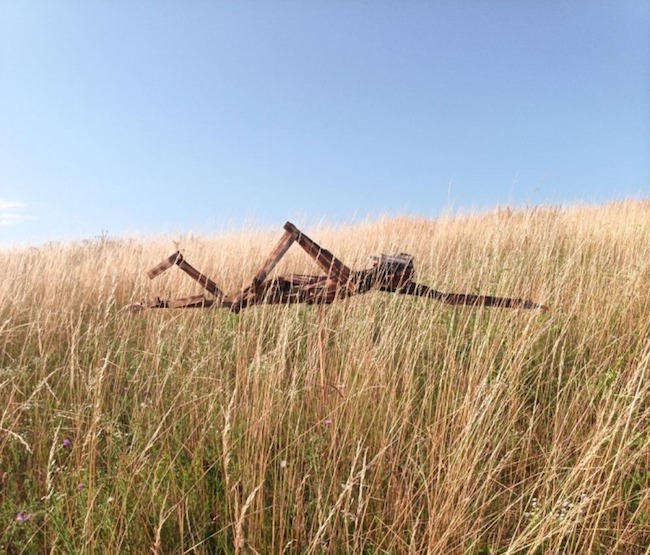
I corpi dei personaggi dell’artista sono spesso composti da brevi tasselli di legno fissati gli uni agli altri in modo da poter esprimere il senso sfaccettato della realtà, quel comporsi attraverso frammenti di esperienze e di sensazioni che definiscono non solo l’interiorità dell’individuo bensì anche l’aspetto esteriore. Non vi è ansia o angoscia nelle sculture di Mathes, piuttosto l’apertura alla sperimentazione, la curiosità positiva che induce l’umano a spingersi oltre i limiti e i confini che la società vorrebbe imporre; il senso di solitudine non spaventa anzi, diviene un mezzo per affermare la propria personalità, quel bisogno di ricercare se stessi in virtù di un dialogo intimo e consapevole con cui è possibile raggiungere la consapevolezza e rafforzare le caratteristiche che compongono la singola personalità. Quando descrive gli oggetti Mathes si avvicina al Surrealismo per la sua capacità di dare un senso differente a qualcosa ponendolo al di fuori del contesto abituale e rendendolo assoluto protagonista della sua ricerca artistica; l’interazione tra la raffigurazione e le venature del legno scelto per le sculture diviene fondamentale ad armonizzare la natura all’arte, tema a lui particolarmente caro, e per accentuare la sua filosofia del dialogo costante con l’ambiente che l’essere umano vive, che abita e che troppo spesso tende a dimenticare perché soffocato dal cemento dei palazzi cittadini e dall’asfalto delle strade.
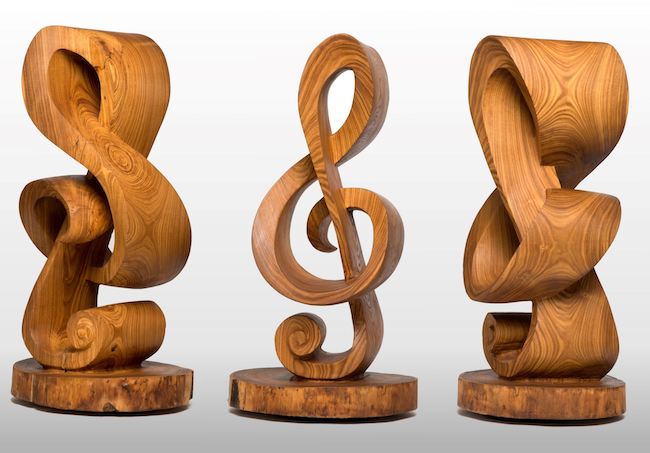
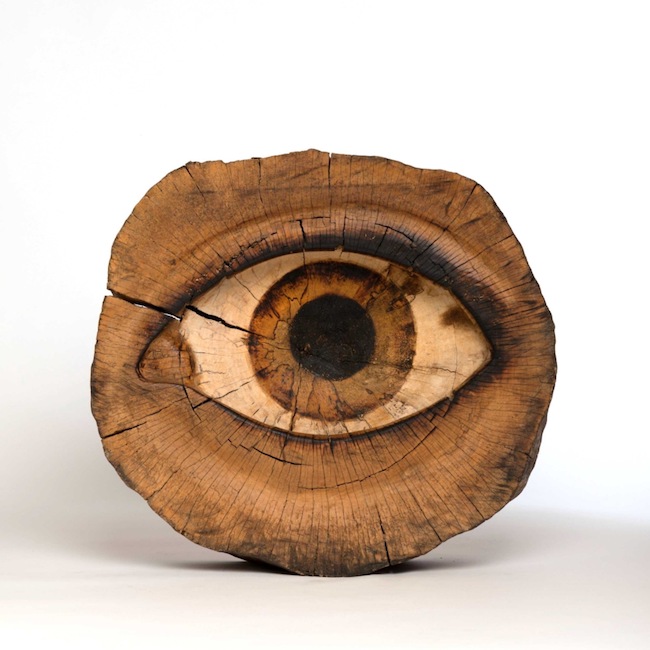
L’opera Auge II (L’occhio II) esprime il forte orientamento surrealista che l’artista mostra assumendo come simbolo lo sguardo umano che, come in tutta la sua produzione, non appare spaventato o disorientato, bensì incuriosito dalla realtà circostante, aperto alla conoscenza, alla scoperta e all’accoglienza del nuovo; i materiali utilizzati sono legno di castagno, fuoco, cera e olio, a sottolineare la tendenza alla sperimentazione che contraddistingue questo bravo artista austriaco.
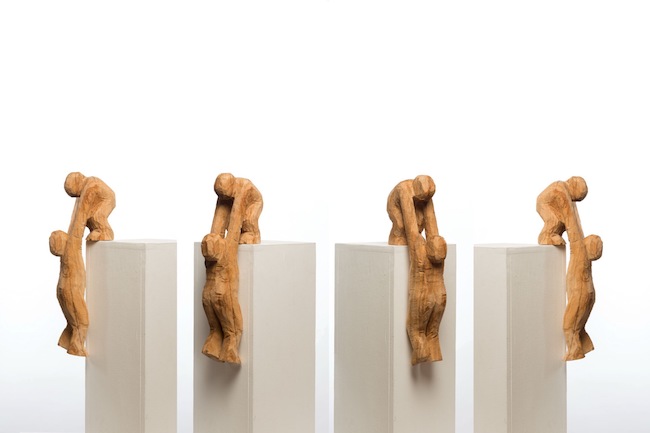
In Helferleins Podest (Il piedistallo dell’aiutante) Mathes narra di un mondo ideale in cui l’uomo sostenga e corra in soccorso dell’altro, del suo simile, auspicando in questo modo un’inversione di tendenza della società attuale in cui spesso il diverso da sé viene visto come antagonista, entità contrapposta; nel gruppo di sculture invece l’individuo si trasforma in sostenitore generoso e solerte, infonde nell’osservatore il senso di comunità, di società esemplare che può nascere solo quando il timore verso ciò che è esterno lascia il posto all’apertura che la differenza, di forza, di determinazione, di razza o di religione, possa costituire un arricchimento e un’evoluzione per l’intera comunità.

L’intensità espressiva viene però raggiunta nel momento in cui l’attenzione si rivolge alla singolarità dell’essere umano, quel porsi al centro di se stesso in maniera esplorativa, non chiusa all’esterno bensì pronta a interagire, a dialogare con il mondo circostante, a scoprire tutto ciò che quest’ultimo offre superando spesso anche i propri limiti, le gabbie dentro cui l’individuo si chiude solo per timore di fallire.
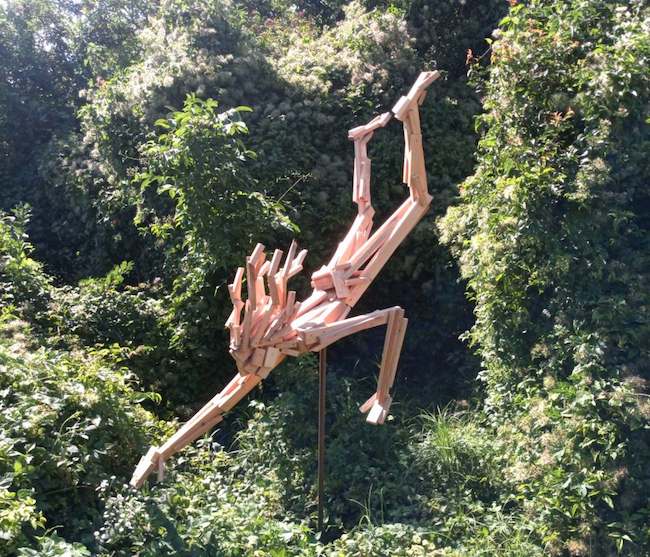
Ecco dunque che il contatto con la natura è fondamentale per indurlo a trovare il coraggio di essere se stesso, di sognare, di osare, come nel caso della scultura Taucherin (La tuffatrice) che Mathes non pone in prossimità di un corso d’acqua bensì in una foresta che diviene spettatrice di un salto nel buio della donna, dell’atto di coraggio a cui spesso molte persone rinunciano a causa del rischio dell’incognito, del non conosciuto che però potrebbe rivelarsi la scelta migliore; la caduta non infonde la sensazione di precipitare piuttosto quella di planare in volo verso opportunità migliori, verso un dopo che è un’evoluzione del prima, un inizio portatore di inedite possibilità.
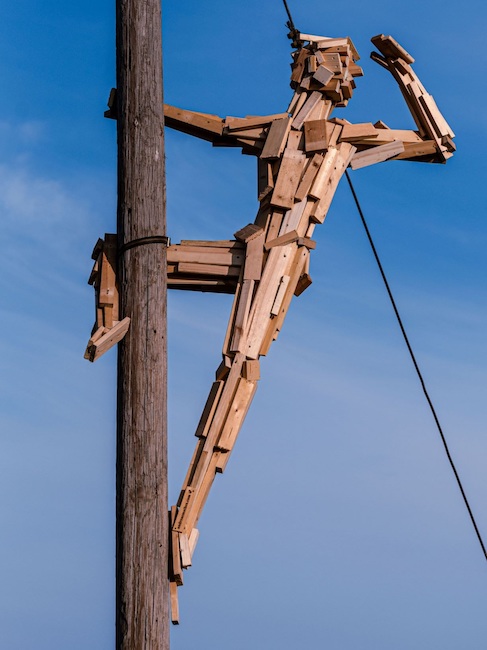
E ancora in Der Späher (L’esploratore), Andreas Mathes non può fare a meno di sottolineare l’atteggiamento di ascolto di quelle energie sottili, di apertura nei confronti del non conosciuto in grado di indurre l’individuo a elevarsi, ad ampliare il suo mondo, la sua zona sicura, per scrutare l’orizzonte cercando di scoprire cosa si nasconda oltre. Figlio di due pittori amatoriali e con alle spalle una carriera di scenografo teatrale, dal 2014 sceglie di dedicarsi solo all’arte e da quel momento partecipa a molte mostre collettive e personali in Austria e in Svizzera, viene notato nell’ambito di importanti premi artistici ed è membro di diverse associazioni artistiche austriache.
ANDREAS MATHES-CONTATTI
Email: atelier@andreasmathes.com
Sito web: www.andreasmathes.com
Facebook: https://www.facebook.com/profile.php?id=100010593436305
Instagram: https://www.instagram.com/anders.mathes/
The surreal voice of wood in Andreas Mathes’ sculptures
Imagining worlds other than those belonging to the contingent reality is an artistic manifestation that has had the magnetic capacity to attract the observer precisely because of its bizarre nature, its similarity to something seen and at the same time completely different; in sculpture, instilling a sense of detachment from the observed, evoking a possible world unrelated to contingency, has been more complex, less easily understood than in painting. The artist I am going to talk about today succeeds perfectly in outlining a reality parallel to the objective one through the use of wood, a ductile material and therefore capable of becoming an expressive voice of great intensity.
At the beginning of the twentieth century, artistic research shifted away from aesthetics and the reproduction of observed reality towards the exploration of inner feelings, an approach that was initially embraced by Expressionism but then spread to many other currents of the time, albeit with different nuances. Those first steps taken by the Expressionists were parallel to a philosophical and cultural vision defined as Existentialism, which sought to investigate man’s discomforts, fears, sense of loss of certainty and inner solitude in the period between the 19th and 20th centuries and which inspired studies on the psyche and the artistic movements of the following decades. Unreality and the world of dreams, as well as nightmares, became the guiding principles of Surrealism, which based its entire poetics, expressive intent and the success of the works of artists such as Salvador Dali, René Magritte, Max Ernst, Hans Arp and Yves Tanguy on the investigation of the unconscious mind, in which the gaze was captured by known elements that, however, took on a completely different meaning from everyday life, precisely because they were decontextualised, modified and shaped by the illogical oneiric, or in other cases absolutely discordant and belonging to a parallel world never found in objectivity.
This fascinating, enigmatic and sometimes disturbing current was approached by a sculptor who was decidedly unconventional, not so much for the form of his artworks as for the sense of disorientation, incredible solitude and insubstantiality that his man expressed, slender and fragile in the face of the difficulties of living at the time; I am obviously talking about Alberto Giacometti, who constituted a voice outside the chorus with respect to the guidelines of Surrealism, giving life in fact to an artistic Existentialism and paving the way for considerations and personalisations found in Egon Schiele’s Expressionism, in the Nordic Realism of the Danish Vilhelm Hammershøi and in Edward Hopper’s American Realism, in which is highlighted the sense of solitude, the inner silence within which the human being takes refuge or, on the contrary, finds himself living against his will. While Giacometti prefers bronze to tell the story of the emptiness of the human being, Austrian sculptor Andreas Mathes takes up the theme of the solitude of contemporary man, choosing wood to give his point of view, less distressed, more involved in nature, which is considered an essential element for potential salvation, to alleviate the sense of loneliness that envelops today’s life in which individualism seems to be the imperative to follow. Mathes’ large-scale artworks are often placed in outdoor contexts, becoming de facto installations in which the interaction with all that is around, from a meadow to a forest, from a lamp post to a garden, is fundamental in accommodating the actions in the making that his protagonists carry out. The bodies of the artist’s characters are often made up of short pieces of wood attached to each other so as to express the multifaceted sense of reality, that composing through fragments of experiences and sensations that define not only the interiority of the individual but also the exterior appearance.
There is no anxiety or anguish in Mathes’ sculptures, rather the openness to experimentation, the positive curiosity that induces the human being to push beyond the limits and boundaries that society would like to impose; the sense of solitude does not frighten, on the contrary, it becomes a means of affirming one’s own personality, that need to search for oneself by virtue of an intimate and conscious dialogue with which it is possible to achieve awareness and strengthen the characteristics that make up the individual personality. When he describes his objects, Mathes comes close to Surrealism for his ability to give a different meaning to something by placing it outside its usual context and making it the absolute protagonist of his artistic research; the interaction between the depiction and the grain of the wood chosen for the sculptures becomes fundamental in harmonising nature with art, a theme particularly dear to him, and in emphasising his philosophy of constant dialogue with the environment that the human being lives in, that he inhabits and that he too often tends to forget because it is suffocated by the concrete of city buildings and the asphalt of streets. The work Auge II (Eye II) expresses the artist’s strong surrealist orientation, taking as its symbol the human gaze which, as in all his work, does not appear frightened or disorientated, but intrigued by the surrounding reality, open to knowledge, discovery and acceptance of the new; the materials used are chestnut wood, fire, wax and oil, underlining the tendency to experiment that distinguishes this talented Austrian artist. In Helferleins Podest (The Helper’s Pedestal) Mathes tells of an ideal world in which man supports and runs to the aid of the other, of his fellow human being, thus hoping for a reversal of the trend in today’s society in which people who are different from themselves are often seen as antagonists, opposing entities; in the sculpture group, on the other hand, the individual is transformed into a generous and diligent supporter, instilling in the observer a sense of community, of an exemplary society that can only come into being when the fear of what is external gives way to an openness to the fact that the difference in strength, determination, race or religion can constitute an enrichment and an evolution for the entire community.
Expressive intensity is achieved, however, when attention is turned to the singularity of the human being, that placing oneself at the centre in an exploratory manner, not closed to the outside world but ready to interact, to dialogue with the surrounding world, to discover all that the latter offers, often overcoming one’s own limits, the cages within which the individual closes himself only for fear of failure. This is why contact with nature is fundamental in inducing him to find the courage to be himself, to dream, to dare, as in the case of the sculpture Taucherin (The Diving Woman), which Mathes does not place near a water course but in a forest that becomes the spectator of a woman’s leap into the dark, the act of courage that many people often renounce because of the risk of the unknown, of the unknown that could, however, prove to be the best choice; the fall does not instil the sensation of precipitating, but rather that of gliding in flight towards better opportunities, towards an aftermath that is an evolution of the before, a beginning that brings new possibilities. And again in Der Späher (The Explorer), Andreas Mathes cannot fail to emphasise the attitude of listening to those subtle energies, of opening up to the unknown that can induce the individual to rise, to expand his world, his safe zone, to scan the horizon trying to discover what lies beyond. Son of two hobby painters, with a career as a theatre set designer, in 2014 he decided to devote himself solely to art, and since then has taken part in many group and solo exhibitions in Austria and Switzerland, has been noticed at important art prizes and is a member of various Austrian art associations.


